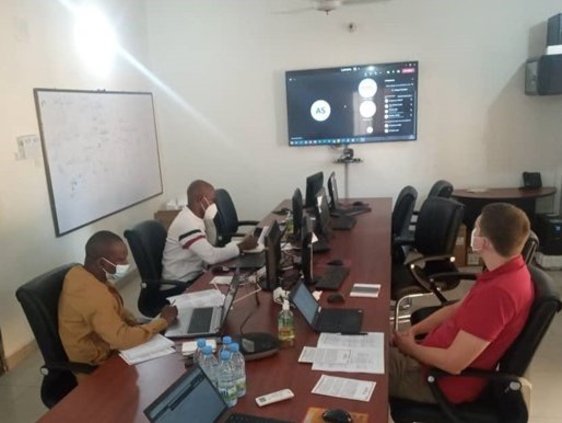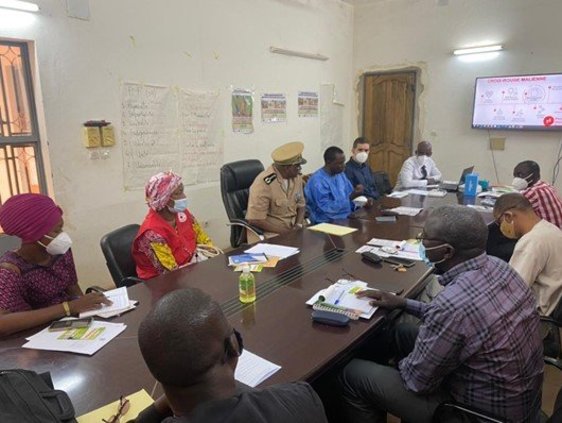Categories
Practice makes perfect: forecast-based action in Mali
As the rainy season comes to an end in the Central Sahel, it is time for Mali Red Cross – in partnership with Danish Red Cross – to take stock of the work done on forecast-based action this year. A range of different activities have been undertaken to ensure disaster preparedness, especially regarding the heightened flood risk in Mali’s southern and central regions.
“The readiness activities are extremely important for us” says Toke J. Rogbo-Bengtsson, the forecast-based financing (FbF) delegate for the Danish Red Cross. “In our Early Action Protocol, we only have a 4-day lead time, so everyone must know their role and what is expected of them if we trigger. Therefore, we put a lot of effort into these preparations.”

Mali Red Cross staff, along with the Danish Red Cross FbF Delegate, participate in the tabletop simulation at the Emergency Operation Centre at the Mali Red Cross headquarters in Bamako. Photo © Mali Red Cross

Refresher training for the regional crisis committee of Segou. Photo © Mali Red Cross

Mali Red Cross staff, along with the Danish Red Cross FbF Delegate, participate in the tabletop simulation at the Emergency Operation Centre at the Mali Red Cross headquarters in Bamako. Photo © Mali Red Cross
Refresher training for the regional crisis committee of Segou. Photo © Mali Red Cross
Getting ready
The Early Action Protocol (EAP) for Floods in Mali outlines actions including: the prepositioning of stock, including emergency shelters and household items; sandbags to protect houses and key infrastructure; water, sanitation and hygiene (WASH) supplies to ensure access to safe water; and mosquito nets to prevent vector-borne diseases.
Prepositioning the stock required for early actions is a unique feature of Red Cross Red Crescent EAPs, which are funded by the IFRC’s ‘Forecast-based Action by the DREF’ fund. This approach allows for timely interventions if the trigger in the EAP is met.
Other readiness activities organised by the Mali Red Cross in the last months range from refresher training course for regional crisis committees and volunteer teams, through to joint river-level monitoring with the Direction National de l’Hydraulique. The latter activity underscores the importance of synergetic action among partners and key stakeholders, ensuring the coordinated and successful execution of activities.
These readiness activities help maintain relationships with our partners, whilst fostering coordination and raising awareness about preparedness. This is especially valid for our most important stakeholder – vulnerable communities. Sensitising them about the importance of preparedness, while giving them ownership in the process, not only reduces any potential friction, but also bolsters the collection of accurate data.
Time for testing
A final piece in the preparedness puzzle was a tabletop simulation, which probed the activation mechanism of the EAP. This three-hour simulation was conducted fully remotely, with an adaptive methodology and participants spread across six countries. The simulation tested coordination between the Mali Red Cross and IFRC, ensuring that roles and responsibilities at every level are clear. Themes ranged from early warning to activation, touching upon the logistics of prepositioned stock, COVID-19 preparedness, communication with local communities, and scaling up – either of early actions, or in terms of a response – if the disaster goes beyond the scope of the EAP.
Key lessons
This simulation:
helped the Mali Red Cross confirm, with a degree of confidence, that the EAP has all the relevant information required for its quick activation
was a good test of standard operating procedures
reinforced the complementarity between various Mali Red Cross departments, which is required to facilitate a smooth activation
highlighted shortcomings in inter-departmental coordination, paving the way for future work
tested IFRC’s readiness to activate the early actions and reinforced coordination between the Mali Red Cross and its counterparts at the IFRC.
Next steps
A key output from the simulation exercise is a comprehensive set of 12 concrete recommendations for the Mali Red Cross, as well as for the IFRC. To implement these recommendations, the Mali Red Cross will revise the EAP and reallocate readiness funds to ensure that essential recommendations are addressed, if there are financial implications. The recommendations can be taken forward both separately and jointly in advance of the next rainy season, to ensure a smooth and timely activation and potential scale up of the EAP, if required.
This blog was written by Laura Bonanomi, with contributions from Toke J. Rogbo-Bengtsson and Melanie Ogle. For more information, please contact Souleymane Konate, FbF focal point for Mali Red Cross and Pierre Danladi, FbF focal point for IFRC Niamey Delegation. You can read more out forecast-based action in Mali on our project page.
